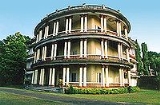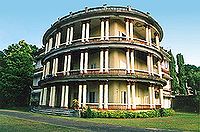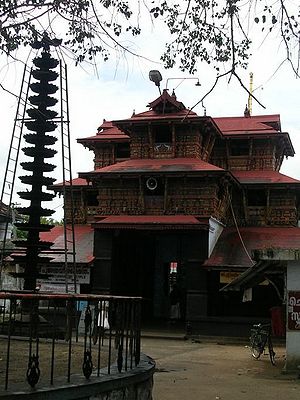
Cochin Royal Family
Encyclopedia


Tradition of Perumpadapu Swaroopam

Kerala
or Keralam is an Indian state located on the Malabar coast of south-west India. It was created on 1 November 1956 by the States Reorganisation Act by combining various Malayalam speaking regions....
(spiritual head being Azhvanchery Thamprakkal
Azhvanchery Thamprakkal
The Azhvanchery Thamprakkal or Azhvanchery Samrat is the title of the senior most male member of the Brahmin feudal lords of Azhvanchery Mana, located in Athavanad, present day Malappuram district, Kerala state, South India...
). Their rituals and tradition is almost similar to that of Brahmins with some exceptions like 12 days of Pollution on death or Birth, Veli not performed for marriages of male members, cannot do pooja yagam etc. Normally for Sandhya vandanam members recite 10 Gayatri
Gayatri
Gayatri is the feminine form of , a Sanskrit word for a song or a hymn. Gayatri is a consort of Brahma and the goddess of learning. Brahma married her when there was a need for a companion during a yajna. Brahma had to start the yajna along with his wife...
mantrams. Among the ruling families in kerala only members of Perumpadappu swaroopam traditionally had the right to Serve feast to Brahmins or can have food together with Brahmin(thachudya kaimal of kudalmanikya kshetram also have that right). This can be verifed by reading Shaktan Thampuran story in Ayithihyamaala of kottarathil Shankunni.We can see there is a strong relation of Cochin dynasty with the Christian community.The elephant lamp presented by Shaktan Thampuran to the Saint Mary's Church, Kanjoor
Kanjoor
Kanjoor is a small town near to Aluva. It is in Ernakulam district in the state of Kerala, India.[Kanjoor] is a panchayat in the Ernakulam District. It has as many as 14 wards. The estimated population is 25,000...
proving the above fact. Every member has to do Shodasakriyakal. The term "Shodasakriyakal" refers to sixteen rites to be performed by all members, as structured through "Smruthi".
- Sekom (Garbhaadhaanam) : A rite to be performed just before the first sexual intercourse after marriage.
- PumsavanomPumsavanamPumsavana is the second of the 16 saṃskāras practiced by the Hindus. It is performed in the third or fourth month of pregnancy. The pregnant women consume one bead of barley and two beads of black grain along with a little curd accompanied by religious chanting. The relatives offer lots of...
: To be performed just after conception. - Seemantham : Performed after PumsavanomPumsavanamPumsavana is the second of the 16 saṃskāras practiced by the Hindus. It is performed in the third or fourth month of pregnancy. The pregnant women consume one bead of barley and two beads of black grain along with a little curd accompanied by religious chanting. The relatives offer lots of...
. - Jathakarmam : Performed just after birth.
- Naamakaranam : Naming Ceremony of the child.
- (Upa)nishkramanam (Vaathilpurappadu) : Involves taking the child out of the house for the first time.
- Choroonu : The first ceremonial intake of rice by the child.
- Choulam : The first hair-cut ceremony of the boy/ girl.
- UpanayanamUpanayanamUpanayana is the initiation ritual by which initiates are invested with a sacred thread, to symbolize the transference of spiritual knowledge .- Significance of the sacred thread :...
: (Only for boys). - Mahaanamneevrutham (Aanduvrutham) :
- Mahaavrutham :
- Upanishadvrutham :
- Godaanam : Rites as part of thanks-giving to the Aacharyan (priest or teacher).
- Samaavarthanam : A long ritual for the completion of the above said Vedic education.
- Marriage
- Agniadhaanam : A rite performed as an extension of Oupaasanam and introduction to Sroutha rites.
Deities

- Paradevatha (goddess): Vannery Chitrakoodam, Pazhayannur Bhagavathy, Chazhur Pazhayannur Bhagavathy
- Paradevan (god): VishnuVishnuVishnu is the Supreme god in the Vaishnavite tradition of Hinduism. Smarta followers of Adi Shankara, among others, venerate Vishnu as one of the five primary forms of God....
(Sree PoornathrayeesaSree Poornathrayesa templeSree Poornathrayesa temple is situated in Tripunithura, Kochi, the capital of the former Kingdom of Cochin.The temple is very famous in our kerala and also india....
), Tiruvanchikulathappan (Lord Shiva of ThiruvanchikulamThiruvanchikulamThiruvanchikkulam was the capital of the Chera kingdom. Thiruvanchikulam is situated near the modern city of Kochi in the Kerala Province of modern India south to Mahodayapuram and north to former Muziris, the famous sea port on the Malabar coast...
between North ParavurNorth ParavurNorth Paravur formerly known as Parur is a town, municipality in Ernakulam district in the Indian state of Kerala. It is an old and growing municipality. Paravur is the capital of Paravur Taluk in Ernakulam district...
and Kodungallore) - Other Deities: Chottanikkara BhagavathyChottanikkara TempleThe Chottanikkara Temple is a famous temple of the Hindu mother goddess Bhagawati. The temple is located near Ernakulam in the southern Indian state of Kerala and is one of the most popular temples in the state and in terms of temple architecture,this temple stands out to be an ultimate...
, Pulpalli Thevar and many
Marriage
Traditionally the female members of the family are married (SambandhamSambandham
Sambandham was a form of marital system primarily followed by the Nairs in what is the present-day Indian state of Kerala. This system of marriage was followed by the matriarchal castes of Kerala, though today the custom has ceased to exist...
) only to Namboodiri Brahmins while male members marry ladies of the Nair
Nair
Nair , also known as Nayar , refers to "not a unitary group but a named category of castes", which historically embody several castes and many subdivisions, not all of whom bore the Nair title. These people historically live in the present-day Indian state of Kerala...
/Samanthan
Samanthan
Samantan Nair or more commonly Samantan was a generic term applied to dignify a collection of Kshatriya sub-clans among the ruling elite and feudal estate owners of Kerala belonging to the Nayar race.-Historical background:Kerala was under the second Chera Empire approximately during 800...
class. These wives of the male members are not Ranis as per the matriarchal system but instead get the title of Nethyar Amma
Panapillai Amma
Panapillai Amma was the title held by the consort of the ruling Maharajah of Travancore. Its literal translation is 'the royal consort' since as per the formerly existent matriarchal system in Travancore, the Maharajah's sister, and not his wife, was the Maharani. Thus the wife took the title of...
. But today with Namboothiris marry within their class Perumpadappu Swaroopam members marry from other Malayala Kshatriya
Malayala Kshatriya
The Samanta Kshatriya are the topmost subdivision of the Malayala Kshatriya Community in Kerala, India. The Samanta Kshatriyas make up a part of the erstwhile royal families of the Hindu Kingdoms and princely states that existed in Kerala until the creation of the Indian Republic...
s class in Kerala. Traditionally the rule for marriage is females marry from same class (like thirupad) or class above (Namboothiri) and males marry from same class (like thirupad) or Nairs.
Naming practice of male Thampuran
In Cochin royal family all the male Thampurans were named according to the following methodology.- Eldest son to a mother Goda Varma (no longer used)
- Second Son Rama VarmaRama VarmaThe name Rama Varma refers to a number of persons from many royal families of Kerala, including many members of the Cochin Royal Family:* Rama Varma Sakthan Thampuran* Sir Sri Rama Varma a.k.a Rajarshi and Abdicated Highness of Cochin...
- Third Son Kerala Varma
- Fourth Son Ravi VarmaRavi VarmaThe name Ravi Varma refers to a number of persons from many royal families of Kerala, including many members of the Cochin Royal Family:* Maharaja Ravi Varma Kunjappan Thampuran, Maharaja of Cochin from 1943-1946* Raja Ravi Varma, painter and artist...
.
From then on to till date the last three naming convention is followed. But the name Goda varma is followed in the other root family (moola thavazhi) of cochin royal family namely chazur kovilakam.
Reference – Genealogy of Cochin Royal Family
Naming practice of female Thampuran
In Cochin Royal Family the female Thampurans were named according to the following methodology.- Eldest daughter To A Mother – Amba
- Second daughter – Ambika
- Third Daughter – Subhadra
This naming convention is followed again to third daughter and fourth etc.
Both the female and male members are called by the name "Thampuran" and have same last name(Thampuran). (in all other royal families in Kerala, males are called Thampuran and females – Thampuratti. For more details, please visit http://www.crfhs.org)

